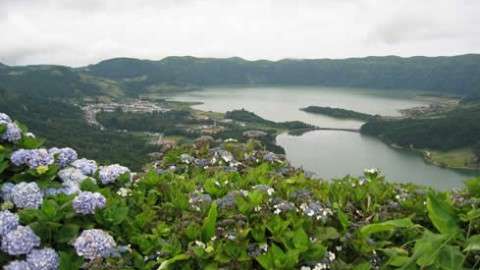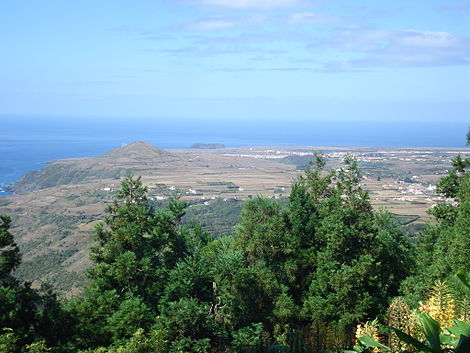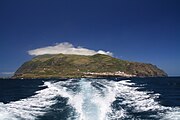A group of nine islands in the North Atlantic Ocean, the Azores belong to Portugal and settled in 1439, the capital is Ponta Delgada on São Miguel Island. This archipelago has formed the Autonomous Region of the Azores in 1976.
The Açores are actually the tops of some of the tallest mountains on the planet, as measured from their base at the bottom of the ocean. They were found by the navigators as they went on the passage of discovery of the new world and settled by people from the Algarve and later by French, Flanders, and even evidence of seafarers from India.
These nine volcanic islands are situated in the northern Atlantic and have a subtropical climate. In many places, the terrain is steep and rugged, and the roads wind around very steep hillsides, making for some very dramatic scenery.
The first islands were “discovered” in the fourteenth century, although it is commonly said that the archipelago received its name for the goshawk (Açor in Portuguese) due to it being a common bird at the time of discovery. The name may also derive from the word “azure”, meaning “blue” in and used by those sailors who identify the islands by their blue colour as they appeared in the distance by sea.
The majority of the inhabitants of the Azores are Portuguese, descendants of 15th-century immigrants from Algarve and from Minho, with a minor Dutch admixture (particularly from Flanders). Settlers were a mixed group of Madeirans, Moorish prisoners, enslaved Africans, French, Italians, Scots, English, Germans and Flemings. There were petty criminals, Spanish clergy, Jews, soldiers, government officials, European merchants and sugar cane growers.
São Miguel, the largest island, was first settled in 1444, mainly from the Estremadura, Alto Alentejo and Algarve areas of Portugal, landing at the site of modern-day Povoação. In 1522 Vila Franca do Campo, then the capital of the island was devastated by a landslide caused by an earthquake which killed about 5,000 people, and the capital was moved to Ponta Delgada. Since the first settlement, the pioneers applied themselves to the area of agriculture.
The official language is Portuguese, the variety of Portuguese spoken is very similar to standard European Portuguese with the exception is the dialect spoken by many of the inhabitants of the largest island, Sao Miguel, even the people from Portugal mainland find it difficult to understand them at first. Because these once uninhabited, remote islands were settled sporadically over a span of two centuries, their culture, dialect, cuisine and traditions vary considerably from island to island.
Fresh fish is very good but there is a “meat and potatoes” mentality when it comes to the cuisine. Sao Jorge is famous for its cheese and must be tried. One of the many activities to do on the islands is whale watching, sailing, diving, and hiking.
Today people connected to the Azores are living around the globe, including myself. With a strong sense of community and unique ancestral bond, pride in their unique cultural history keeps them connected. The Azores are not well known to most of the world, usually, its only mainland Portugal and Madeira that are recognised, but these islands really are ‘off the beaten track’ and off the map when it comes to global tourism.
Lagoa das Sete Cidades, is storied with myths and legends.

History
The first reference to the island of São Jorge was made in 1439 but the actual date of discovery is unknown. In 1443 the island was already inhabited but active settlement only began with the arrival of the noble Flemish native Wilhelm Van der Haegen, arriving at Topo, where he lived and died. By 1490, there were 2,000 Flemings living in the islands of Terceira, Pico, Faial, São Jorge, and Flores. Because there was such a large Flemish settlement, the Azores became known as the Flemish Islands or the Isles of Flanders.
Since the 17th century, many Azoreans have emigrated, mainly to Brazil, the United States and Canada. Rhode Island and Southeastern Massachusetts, especially the cities of New Bedford, River Point, and Fall River have been, and continue to be the primary destination for Azorean emigrants. Northern California was the final destination for many of the Massachusetts immigrants who then moved on to the San Joaquin Valley. From 1961 to 1977, about 150,000 Azoreans immigrated to the United States and Canada.
During the Second World War, in 1943, the Portuguese dictator leased bases in the Azores to the British, a key turning point in the Battle of the Atlantic, allowing the Allies to provide aerial coverage in the middle of the Atlantic. This helped them to hunt U-boats and protect convoys. In 1944, American forces constructed a small and short-lived air base on the island of Santa Maria, a new base was constructed on the island of Terceira in 1945, currently known as Lajes Field, this Air Force base is a joint American and Portuguese venture and continues to support the United States and Portuguese military operations. The airfield also has a small commercial terminal handling scheduled and chartered passenger flights from other islands in the archipelago, Europe, and North America.
São Miguel Island
The largest island, home to myths and legends and location of Lagoa das Sete Cidades, it is where I originate from and birthplace, the capital is Ponta Delgada. Village life in the town of Achada.
Santa Maria Island
An island located south of the island of São Miguel, and the southernmost island in the Azores. The island is primarily known in the islands for its white-sand beaches, distinct chimneys, and dry warm weather that makes them unique in the Portuguese islands.

Terceira Island
One of the larger islands of the archipelago, is the location of the historical capital of the archipelago, the Azores‘ oldest city and UNESCO Heritage Site (Angra do Heroísmo), the seat of the judicial system (Supreme Court), the main base of the Azores Air Zone Command (Commando da Zona Aérea dos Açores) Base and the United States Air Force detachment.
Faial Island
Known in English as Fayal, he nearest island is Pico Island to the east. The island is also referred to as Ilha Azul (the “Blue Island”), due to the large number of Hydrangeas that bloom during the summer months.

Graciosa Island
Literally “graceful” or “enchanting” in Portuguese, is referred to as the White Island, he ovular Portuguese island with a length of 10km and a width of 7 km. It is a volcanic island, dominated by a 1.6 km wide central caldera (the Caldeira) located in the southeast.

São Jorge Island
In the central Azorean archipelago, separated from its nearest neighbors (Pico and Faial islands) by a 15km strait. São Jorge’s is a relatively long thin island with tall cliffs.

Flores Island
An island of the Western group of the Azores, a population of approximately 3907 inhabitants, and lies within the North American Plate, best recognized for its abundance of flowers, hence its Portuguese name of Flores.





